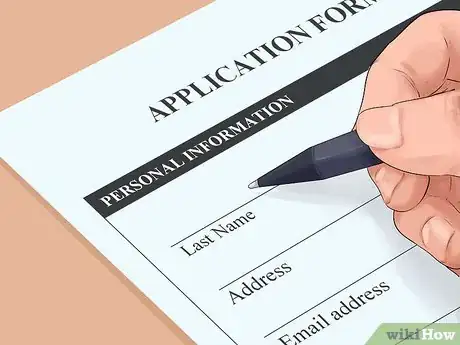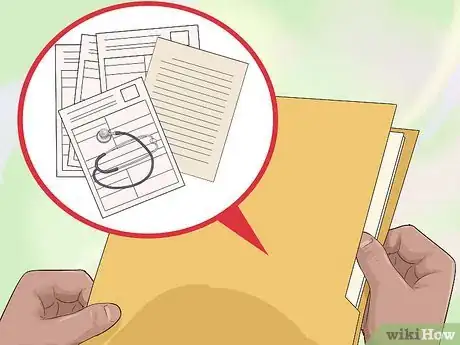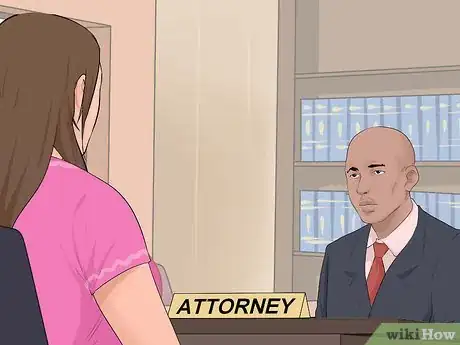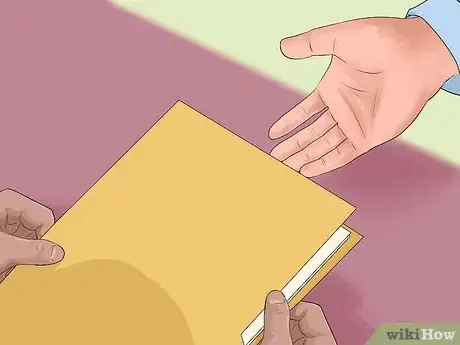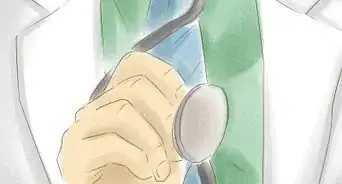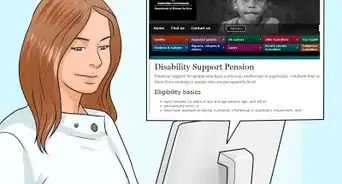This article was written by Jennifer Mueller, JD. Jennifer Mueller is an in-house legal expert at wikiHow. Jennifer reviews, fact-checks, and evaluates wikiHow's legal content to ensure thoroughness and accuracy. She received her JD from Indiana University Maurer School of Law in 2006.
There are 7 references cited in this article, which can be found at the bottom of the page.
This article has been viewed 26,315 times.
If you have become disabled and can no longer work, you may be eligible to receive disability benefits. Private insurers and the federal government typically define long-term disability as one your doctors believe will last a year or longer, or will be fatal. Because it can take months before your application is approved and you start receiving benefits, you should apply for long-term disability benefits as soon as possible after your doctor diagnoses your disability and confirms your inability to work.[1]
Steps
Applying for Benefits from a Private Insurer
-
1Read your policy. If you have a private long-term disability policy and you've become disabled, your policy documents will explain the process for applying for benefits.
- Your policy specifies the disabilities that are covered by your policy as well as how to file a claim. Make sure you are already seeing a doctor before you apply for benefits, since the insurance company will want proof of your disability and will need to review your medical records and discuss your impairment with your doctor.
- Look for the plan's definition of disability. This definition essentially outlines what you have to prove to be eligible for benefits under your policy.[2]
- Certain conditions, such as those related to pre-existing conditions, or to drug or alcohol abuse, typically are excluded from coverage. Similarly, your benefits may be limited if your disability is based more on subjective complaints than on an objectively quantifiable impairment. Examples of such conditions include depression and fibromyalgia.[3]
- Keep in mind that if your policy was provided by your employer, it is governed by federal law. The Employee Retirement Income Security Act (ERISA) regulates applications for long-term disability benefits under these policies.[4]
- Under ERISA, you have the right to receive a copy of your plan description and policy documents upon written request.[5]
-
2Complete your application. Private insurers typically will have an initial application you must fill out to provide the company with information about your disability.
- Use the information you learned from reading your policy to determine the type of information you must include in your application or claim form to prove to the insurance company that you are disabled and entitled to receive benefits.[6]
- Make a note of all deadlines and make sure you've submitted your application and any related documentation by the dates provided. If you miss a deadline, your insurer may use it as a reason to deny your claim.[7]
Advertisement -
3Get appropriate documentation. To qualify for long-term disability benefits, you must prove to your ensurer that you are no longer able to work due to a disability expected to last more than a year.
- Your insurer most likely will request all medical records related to your disability, including any laboratory or test results, clinical notes, and exam reports.[8]
- You might want to consider getting copies of your medical records yourself before submitting them to your insurer, so you know what they include and can analyze how this information might be used either to approve or deny your claim.[9]
- Make sure you submit all documents requested, particularly medical evidence, as soon as possible after it has been requested. This ensures you won't miss any deadlines and decreases the changes that the insurance company will deny your claim.[10]
- You might consider getting your doctor to write a letter supporting your application for benefits. Your doctor can explain your disability and how it limits your ability to work.
- Keep in mind that your doctor may charge a fee to write a detailed report of your disability and medical history for you, but generally this fee will be worth it if the letter significantly increases your chances of receiving long-term disability benefits.[11]
- While your doctor's opinion is important, you also need objective proof of your disability and its effect on your ability to perform your job.[12]
-
4Work with your claims administrator. Your claim will be assigned to a claims administrator, who typically is someone who works for your insurance company.
- Your claims administrator may contact you for additional information or to request documents or contact information for your doctors or other health care providers.
- Keep in mind that most private insurers who approve you for long-term disability benefits also will require you to apply for Social Security benefits. If you are approved for Social Security disability, the insurance company is only responsible for amounts your Social Security benefits don't cover.[13]
-
5Consider consulting an attorney. Because ERISA claims are complicated and frequently denied, you may want advice from an attorney who specializes in ERISA and long-term disability claims.[14]
- If you apply for disability and are denied, you have the right under ERISA to sue the insurance company in federal court. However, it is exceedingly difficult to convince a court to overturn an insurance company's denial of benefits.[15]
- Keep in mind that an attorney can not only help you submit an application but knows how to maximize the chances that you will be approved for benefits.
Applying for Social Security Benefits
-
1Download the Disability Starter Kit. The Social Security Administration (SSA) provides a starter kit with basic information about Social Security law and the types of long-term disability benefits available.[16]
- The kit includes and overview of what to expect from the application process, as well as a checklist and a worksheet to help you organize your information and make sure you have all the documents the SSA needs to process your application.
- If you're unable to download the kit online, you also can request one be mailed to you by calling the SSA at 1-800-772-1213.
-
2Gather documents and information. You can use the checklist provided in the starter kit to make sure you have all the information needed to complete your application.[17]
- You will need the names, addresses, and phone numbers of all of your medical providers, as well as the dates you visited those doctors or facilities and copies of your records from those visits, including laboratory or test results.[18]
- Concentrate on the documents you already have in your possession. The SSA will assist you in requesting additional documentation if it is needed.
- Keep in mind that the more documentation you can provide to back up your claim that you are disabled, the greater the likelihood that your application will be approved.
-
3Complete your application. You can complete a long-term disability application online, by calling the SSA's toll-free telephone number, or by visiting your nearest Social Security office in person.[19]
- The Disability Starter Kit includes a link to the online application. You also can apply either by calling 1-800-772-1213, or by scheduling an appointment at your local SSA office.
- If you want to apply in person, you can find the location and phone number of your nearest SSA office by using the SSA office locator at https://www.ssa.gov/locator/.
- The application requires you to provide details about yourself, your disability, and your work and income history. Generally, you must prove that your disability prevents you from performing work in your field, and that there is no other work available to you elsewhere that you could perform.
-
4Submit required documents. If you apply online or over the phone, you still must submit certain documents to verify the information you provided in your application.[20]
- You should send your documents to your local SSA office, and include your Social Security number with the documents so SSA staff can apply the documents to the correct application.
- Keep in mind that you must send originals, not copies, of many of the required documents. You should send these documents using certified mail with returned receipt requested so you know when the office receives your documents.
- Once the SSA reviews your originals, it will make copies and send your originals back to you. However, if you don't feel comfortable sending original documents through the mail you can always take them down to your local SSA office in person.
-
5Wait for a response. It can take between three and five months for the SSA to process applications for disability benefits.[21]
- After your application and all supporting documentation are received, a medical and vocational expert will review your materials and determine whether you qualify for long term disability benefits.
- You may be contacted by an SSA representative if further information is required to process your application, or if you need to complete additional medical examinations.
- Keep in mind that if the SSA requires you to complete a medical examination, you won't have to pay any money for it. You are, however, responsible for keeping the appointment.
-
6Consider consulting an attorney. Especially if your application is denied, you may want to get advice and assistance from an experienced Social Security disability attorney.
- Keep in mind that long-term disability applications frequently are denied and must go through the appeals process. An experienced Social Security disability attorney understands and can help guide you through this process.
- If you are concerned about the cost of an attorney, you might consider checking with your local legal aid office. Nonprofit organizations dedicated to assisting disabled people also may have legal resources or recommendations for attorneys who provide services for free or using a sliding-fee scale based on your income.
References
- ↑ https://www.ssa.gov/planners/disability/dapply.html
- ↑ http://www.disabilitysecrets.com/resources/disability/disability-social-security/requirements-long-term-disability.htm
- ↑ http://www.nolo.com/legal-encyclopedia/why-long-term-disability-ltd-applications-get-denied.html
- ↑ http://www.nolo.com/legal-encyclopedia/why-long-term-disability-ltd-applications-get-denied.html
- ↑ http://www.nolo.com/legal-encyclopedia/applying-erisa-group-disability-benefits-36127.html
- ↑ http://www.disabilitysecrets.com/resources/disability/filing-disability/filing-long-term-disability-claims-aetna.htm
- ↑ http://www.nolo.com/legal-encyclopedia/why-long-term-disability-ltd-applications-get-denied.html
- ↑ http://www.disabilitysecrets.com/resources/disability/disability-social-security/requirements-long-term-disability.htm
- ↑ http://www.nolo.com/legal-encyclopedia/applying-erisa-group-disability-benefits-36127.html
- ↑ http://www.nolo.com/legal-encyclopedia/why-long-term-disability-ltd-applications-get-denied.html
- ↑ http://www.nolo.com/legal-encyclopedia/why-long-term-disability-ltd-applications-get-denied.html
- ↑ http://www.disabilitysecrets.com/resources/disability/disability-social-security/requirements-long-term-disability.htm
- ↑ http://www.disabilitysecrets.com/resources/disability/disability-social-security/requirements-long-term-disability.htm
- ↑ http://www.nolo.com/legal-encyclopedia/avoid-mistakes-erisa-disability-benefits-36128.html
- ↑ http://www.nolo.com/legal-encyclopedia/applying-erisa-group-disability-benefits-36127.html
- ↑ https://www.ssa.gov/disability/Documents/SSA-1170-KIT.pdf
- ↑ https://www.ssa.gov/disability/Documents/SSA-1170-KIT.pdf
- ↑ https://www.ssa.gov/planners/disability/dapply.html
- ↑ https://www.ssa.gov/planners/disability/dapply.html
- ↑ https://www.ssa.gov/planners/disability/dapply.html
- ↑ https://www.ssa.gov/disability/Documents/SSA-1170-KIT.pdf

